Exploring Trends in Intangible Cultural Heritage Design: A Bibliometric and Content Analysis
Abstract
1. Introduction
- RQ1. How has research in the field of ICHD evolved over time?
- RQ2. What are the primary themes and current issues in ICHD research?
- RQ3. What are the theoretical and practical implications of our study, and what are the future directions for further research in this area?
2. Data and Methodology
2.1. Software and Data
2.2. Methodology
3. Results
3.1. Bibliometric Analysis
3.1.1. Description of the Literature Data
- Annual publications and citations
- Subject areas
3.1.2. Countries/Regions Distribution Analysis
3.1.3. Institutions and Their Collaboration Network Analysis
3.1.4. Journals and Authors Analysis
3.1.5. Citation Analysis
3.2. Content Analysis
3.2.1. Theme Hotspot Analysis
3.2.2. Theme Evolution Analysis
3.2.3. Theme Cluster Analysis
- Management and Sustainable Development of Cultural Heritage
- Protection and Transmission of Intangible Cultural Heritage
- Museum Management and Visitor Experience
- Education and Academic Research
4. Discussion
5. Conclusions
Author Contributions
Funding
Institutional Review Board Statement
Informed Consent Statement
Data Availability Statement
Conflicts of Interest
Appendix A
| Correlation Coefficient/p Value | Heritage | Culture | Sustainable Development | Management | Approach | City |
|---|---|---|---|---|---|---|
| heritage | 1 (0.000 ***) | |||||
| culture | 0.943 (0.001 ***) | 1 (0.000 ***) | ||||
| sustainable development | 0.694 (0.084 *) | 0.894 (0.007 ***) | 1 (0.000 ***) | |||
| management | 0.724 (0.066 *) | 0.912 (0.004 ***) | 0.999 (0.000 ***) | 1 (0.000 ***) | ||
| approach | 0.972 (0.000 ***) | 0.995 (0.000 ***) | 0.844 (0.017 **) | 0.866 (0.012 **) | 1 (0.000 ***) | |
| city | 0.768 (0.044 **) | 0.937 (0.002 ***) | 0.994 (0.000 ***) | 0.998 (0.000 ***) | 0.897 (0.006 ***) | 1 (0.000 ***) |
| Correlation Coefficient/p Value | Intangible Cultural Heritage | Technology | Protection | Model | Cultural Identity | Knowledge |
|---|---|---|---|---|---|---|
| intangible cultural heritage | 1 (0.000 ***) | |||||
| technology | 0.942 (0.001 ***) | 1 (0.000 ***) | ||||
| protection | 0.853 (0.015 **) | 0.978 (0.000 ***) | 1 (0.000 ***) | |||
| model | 0.881 (0.009 ***) | 0.988 (0.000 ***) | 0.998 (0.000 ***) | 1 (0.000 ***) | ||
| cultural identity | 0.586 (0.166) | 0.823 (0.023 **) | 0.923 (0.003 ***) | 0.9 (0.006 ***) | 1 (0.000 ***) | |
| knowledge | 0.803 (0.030 **) | 0.956 (0.001 ***) | 0.996 (0.000 ***) | 0.989 (0.000 ***) | 0.953 (0.001 ***) | 1 (0.000 ***) |
| Correlation Coefficient/p Value | Addition | Museum | Visitor | Exhibition | Experience | Tourist | Music |
|---|---|---|---|---|---|---|---|
| addition | 1 (0.000 ***) | ||||||
| museum | 0.913 (0.011 **) | 1 (0.000 ***) | |||||
| visitor | 0.961 (0.002 ***) | 0.99 (0.000 ***) | 1 (0.000 ***) | ||||
| exhibition | 0.93 (0.007 ***) | 0.999 (0.000 ***) | 0.995 (0.000 ***) | 1 (0.000 ***) | |||
| experience | 0.716 (0.109) | 0.939 (0.006 ***) | 0.881 (0.020 **) | 0.923 (0.009 ***) | 1 (0.000 ***) | 0.822 (0.045 **) | |
| tourist | 0.986 (0.000 ***) | 0.968 (0.002 ***) | 0.994 (0.000 ***) | 0.978 (0.001 ***) | 0.822 (0.045 **) | 1 (0.000 ***) | 1 (0.000 ***) |
| music | 0.984 (0.000 ***) | 0.97 (0.001 ***) | 0.995 (0.000 ***) | 0.98 (0.001 ***) | 0.828 (0.042 **) | 1 (0.000 ***) | 1 (0.000 ***) |
| Correlation Coefficient/p Value | Article | Factor | Innovation | Student | Author |
|---|---|---|---|---|---|
| article | 1 (0.000 ***) | ||||
| factor | 0.986 (0.000 ***) | 1 (0.000 ***) | |||
| innovation | 0.976 (0.001 ***) | 0.999 (0.000 ***) | 1 (0.000 ***) | ||
| student | 0.999 (0.000 ***) | 0.992 (0.000 ***) | 0.985 (0.000 ***) | 1 (0.000 ***) | |
| author | 0.962 (0.002 ***) | 0.994 (0.000 ***) | 0.998 (0.000 ***) | 0.973 (0.001 ***) | 1 (0.000 ***) |
References
- Lee, K.-S. Cooking up Food Memories: A Taste of Intangible Cultural Heritage. J. Hosp. Tour. Manag. 2023, 54, 1–9. [Google Scholar] [CrossRef]
- Ning, H. Analysis of the Value of Folk Music Intangible Cultural Heritage on the Regulation of Mental Health. Front. Psychiatry 2023, 14, 455. [Google Scholar] [CrossRef]
- Zhang, M.; Guo, X.; Guo, X.; Jolibert, A. Consumer Purchase Intention of Intangible Cultural Heritage Products (ICHP): Effects of Cultural Identity, Consumer Knowledge and Manufacture Type. Asia Pac. J. Mark. Logist. 2023, 35, 726–744. [Google Scholar] [CrossRef]
- Ding, H. Digital Protection and Development of Intangible Cultural Heritage Relying on High-Performance Computing. Comput. Intell. Neurosci. 2022, 2022, 4955380. [Google Scholar] [CrossRef] [PubMed]
- Zhao, H.; Zhao, X.; Elahi, E.; Wang, F. Policy Evaluation of Drama-Related Intangible Cultural Heritage Tourism for Boosting Green Industry: An Empirical Analysis Based on Quasi-Natural Experiment. Sustainability 2022, 14, 5380. [Google Scholar] [CrossRef]
- Bortolotto, C. From Objects to Processes: Unesco’s “Intangible Cultural Heritage”. In Proceedings of the Annual Conference of the Museum Ethnographers, Birmingham Museum & Art Gallery, Birmingham, UK, 18–19 May 2006. [Google Scholar]
- Nikolakopoulou, V.; Printezis, P.; Maniatis, V.; Kontizas, D.; Vosinakis, S.; Chatzigrigoriou, P.; Koutsabasis, P. Conveying Intangible Cultural Heritage in Museums with Interactive Storytelling and Projection Mapping: The Case of the Mastic Villages. Heritage 2022, 5, 1024–1049. [Google Scholar] [CrossRef]
- Alivizatou-Barakou, M.; Kitsikidis, A.; Tsalakanidou, F.; Dimitropoulos, K.; Giannis, C.; Nikolopoulos, S.; Al Kork, S.; Denby, B.; Buchman, L.; Adda-Decker, M. Intangible Cultural Heritage and New Technologies: Challenges and Opportunities for Cultural Preservation and Development. In Mixed Reality and Gamification for Cultural Heritage; Springer: Berlin/Heidelberg, Germany, 2017; pp. 129–158. [Google Scholar] [CrossRef]
- Yuan, C.; Gan, L.; Zhuo, H. Coupling Mechanisms and Development Patterns of Revitalizing Intangible Cultural Heritage by Integrating Cultural Tourism: The Case of Hunan Province, China. Sustainability 2022, 14, 6994. [Google Scholar] [CrossRef]
- Li, X.-Z.; Chen, C.-C.; Kang, X.; Kang, J. Research on Relevant Dimensions of Tourism Experience of Intangible Cultural Heritage Lantern Festival: Integrating Generic Learning Outcomes with the Technology Acceptance Model. Front. Psychol. 2022, 13, 943277. [Google Scholar] [CrossRef]
- Udo, E.M. The Vitality of Yoruba Culture in the Americas. Ufahamu J. Afr. Stud. 2020, 41, 27–40. [Google Scholar] [CrossRef]
- Chen, J.; Guo, Z.; Xu, S.; Law, R.; Liao, C.; He, W.; Zhang, M. A Bibliometric Analysis of Research on Intangible Cultural Heritage Tourism Using CiteSpace: The Perspective of China. Land 2022, 11, 2298. [Google Scholar] [CrossRef]
- Duoduo, Z. Ownership of Craft Knowledge in “Live Transmission”: Intangible Cultural Heritage, Digital Games and the Transmission of Technological Skills in Southwest China’s Minority Communities. In Proceedings of the Chinese DiGRA ‘18 Abstract, Shenzhen, China, 8 September 2018. [Google Scholar]
- Lenzerini, F. Intangible Cultural Heritage: The Living Culture of Peoples. Eur. J. Int. Law 2011, 22, 101–120. [Google Scholar] [CrossRef]
- Giliberto, F.; Labadi, S. Harnessing Cultural Heritage for Sustainable Development: An Analysis of Three Internationally Funded Projects in MENA Countries. Int. J. Herit. Stud. 2022, 28, 133–146. [Google Scholar] [CrossRef]
- Tavares, D.S.; Alves, F.B.; Vásquez, I.B. The Relationship between Intangible Cultural Heritage and Urban Resilience: A Systematic Literature Review. Sustainability 2021, 13, 12921. [Google Scholar] [CrossRef]
- Zhao, J.; Wang, Z.; Wang, C.; Han, L.; Ruan, Y.; Huangfu, Z.; Zhou, S.; Zhou, L. Research on the Status of Intangible Cultural Heritage Bearers in the Human Capital Perspective. Front. Psychol. 2022, 13, 850780. [Google Scholar] [CrossRef]
- Zhou, J.; Qi, J.; Shi, X. The Innovation of Entrepreneurship Education for Intangible Cultural Heritage Inheritance from the Perspective of Entrepreneurial Psychology. Front. Psychol. 2022, 13, 721219. [Google Scholar] [CrossRef]
- Karampampas, P. (Re)Inventing Intangible Cultural Heritage through the Market in Greece. Int. J. Herit. Stud. 2021, 27, 654–667. [Google Scholar] [CrossRef]
- Shirvani Dastgerdi, A.; Sargolini, M.; Pierantoni, I. Climate Change Challenges to Existing Cultural Heritage Policy. Sustainability 2019, 11, 5227. [Google Scholar] [CrossRef]
- Ding, Y.; Chowdhury, G.G.; Foo, S. Bibliometric Cartography of Information Retrieval Research by Using Co-Word Analysis. Inf. Process. Manag. 2001, 37, 817–842. [Google Scholar] [CrossRef]
- van Eck, N.; Waltman, L. Software Survey: VOSviewer, a Computer Program for Bibliometric Mapping. Scientometrics 2009, 84, 523–538. [Google Scholar] [CrossRef] [PubMed]
- Cavalcante, W.Q.D.F.; Coelho, A.; Bairrada, C.M. Sustainability and Tourism Marketing: A Bibliometric Analysis of Publications between 1997 and 2020 Using VOSviewer Software. Sustainability 2021, 13, 4987. [Google Scholar] [CrossRef]
- VOSviewer. Visualizing Scientific Landscapes. Available online: https://www.vosviewer.com// (accessed on 30 April 2023).
- Moreno-Guerrero, A.-J.; Gómez-García, G.; López-Belmonte, J.; Rodríguez-Jiménez, C. Internet Addiction in the Web of Science Database: A Review of the Literature with Scientific Mapping. Int. J. Environ. Res. Public Health 2020, 17, 2753. [Google Scholar] [CrossRef]
- Öner, B.S.; Orbay, M. Assessing the Publication Output in the Field of Forensic Science and Legal Medicine Using Web of Science Database from 2011 to 2020. Forensic Sci. Res. 2022, 7, 748–760. [Google Scholar] [CrossRef] [PubMed]
- Ok, G. Bibliometric Evaluation Based on Web of Science Database: Nature and Environmental Education. J. Educ. Gift. Young Sci. 2022, 10, 435–451. [Google Scholar] [CrossRef]
- Feautrier, P. Simplification of Boolean Affine Formulas; HAL open science: Lyon, France, 2011. [Google Scholar]
- Secinaro, S.; Calandra, D.; Lanzalonga, F.; Ferraris, A. Electric Vehicles’ Consumer Behaviours: Mapping the Field and Providing a Research Agenda. J. Bus. Res. 2022, 150, 399–416. [Google Scholar] [CrossRef]
- Agbo, F.J.; Sanusi, I.T.; Oyelere, S.S.; Suhonen, J. Application of Virtual Reality in Computer Science Education: A Systemic Review Based on Bibliometric and Content Analysis Methods. Educ. Sci. 2021, 11, 142. [Google Scholar] [CrossRef]
- Tsiamalou, A.; Dardiotis, E.; Paterakis, K.; Fotakopoulos, G.; Liampas, I.; Sgantzos, M.; Siokas, V.; Brotis, A.G. EEG in Neurorehabilitation: A Bibliometric Analysis and Content Review. Neurol. Int. 2022, 14, 1046–1061. [Google Scholar] [CrossRef] [PubMed]
- Gan, X.-L.; Xie, K.; Liu, H.; Rameezdeen, R.; Wen, T. A Bibliometric and Content Analysis of Policy Instruments on Facilitating the Development of Prefabricated Construction in China. Eng. Constr. Archit. Manag. 2022. [Google Scholar] [CrossRef]
- Yao, M.; Yao, B.; Cenci, J.; Liao, C.; Zhang, J. Visualisation of High-Density City Research Evolution, Trends, and Outlook in the 21st Century. Land 2023, 12, 485. [Google Scholar] [CrossRef]
- Paul, J.; Criado, A.R. The Art of Writing Literature Review: What Do We Know and What Do We Need to Know? Int. Bus. Rev. 2020, 29, 101717. [Google Scholar] [CrossRef]
- Ren, K.; Sun, X.; Cenci, J.; Zhang, J. Assessment of Public Open Space Research Hotspots, Vitalities, and Outlook Using CiteSpace. J. Asian Archit. Build. Eng. 2023, 1–19. [Google Scholar] [CrossRef]
- Scotti Requena, S.; Pirkis, J.; Currier, D.; Nicholas, A.; Arantes, A.A.; Armfield, N.R. The Origins and Evolution of the Field of Masculinity and Suicide: A Bibliometric and Content Analysis of the Research Field. Arch. Suicide Res. Off. J. Int. Acad. Suicide Res. 2022, 1–15. [Google Scholar] [CrossRef]
- Wu, C.; Cenci, J.; Wang, W.; Zhang, J. Resilient City: Characterization, Challenges and Outlooks. Buildings 2022, 12, 516. [Google Scholar] [CrossRef]
- Liang, Y.; Qi, Z. Research on Innovative Design of Tourism Cultural and Creative Products from the Perspective of Huizhou Intangible Cultural Heritage Culture: Taking Wood Carving Patterns as an Example. Sci. Soc. Res. 2021, 3, 228–232. [Google Scholar] [CrossRef]
- Xu, Z.; Zou, D. Big Data Analysis Research on the Deep Integration of Intangible Cultural Heritage Inheritance and Art Design Education in Colleges and Universities. Mob. Inf. Syst. 2022, 2022, 1172405. [Google Scholar] [CrossRef]
- Wang, Q. The Digitisation of Intangible Cultural Heritage Oriented to Inheritance and Dissemination under the Threshold of Neural Network Vision. Mob. Inf. Syst. 2022, 2022, 6323811. [Google Scholar] [CrossRef]
- Kumar, N.; Tandon, R.; Misra, N. Emotional Intelligence as Intangible Class Content for Effective Communication in Managing University Classes: A Bibliometrics Analysis. J. Content Community Commun. 2022, 16, 26–36. [Google Scholar] [CrossRef]
- Ahmad, T.; Haroon; Khan, M.; Murad, M.A.; Baig, M.; Murtaza, B.N.; Khan, M.M.; Harapan, H.; Hui, J. Research Trends in Rabies Vaccine in the Last Three Decades: A Bibliometric Analysis of Global Perspective. Hum. Vaccines Immunother. 2021, 17, 3169–3177. [Google Scholar] [CrossRef]
- Vallega, A. The Role of Culture in Island Sustainable Development. Ocean Coast. Manag. 2007, 50, 279–300. [Google Scholar] [CrossRef]
- United Nations Educational, Scientific and Cultural Organization China. Intangible Cultural Heritage. Available online: https://ich.unesco.org/en/state/china-CN?info=elements-on-the-lists (accessed on 1 June 2023).
- Su, J. A Difficult Integration of Authenticity and Intangible Cultural Heritage? The Case of Yunnan, China. China Perspect. 2021, 3, 29–39. [Google Scholar] [CrossRef]
- Boyu, Z.; Hui, Y.; Schippers, H. Report: The Rise and Implementation of Intangible Cultural Heritage Protection for Music in China. World Music 2015, 4, 45–59. [Google Scholar]
- Xiao, L. Intangible Cultural Heritage Reproduction and Revitalization: Value Feedback, Practice, and Exploration Based on the IPA Model. Comput. Intell. Neurosci. 2022, 2022, 8411999. [Google Scholar] [CrossRef]
- Reguant-Aleix, J.; Arbore, M.R.; Bach-Faig, A.; Serra-Majem, L. Mediterranean Heritage: An intangible cultural heritage. Public Health Nutr. 2009, 12, 1591–1594. [Google Scholar] [CrossRef]
- Paulus, J.; Sprackett, J. EU Nature Restoration Law. 2021. Available online: https://policycommons.net/artifacts/2365457/eu-nature-restoration-law/3386429/ (accessed on 1 June 2023).
- Lafferty, W.; Hovden, E. Environmental Policy Integration: Towards an Analytical Framework. Environ. Polit. 2003, 12, 1–22. [Google Scholar] [CrossRef]
- United Nations Educational, Scientific and Cultural Organization United States of America. Intangible Cultural Heritage. Available online: https://ich.unesco.org/en-state/united-states-of-america-US?info=accredited-ngos (accessed on 15 June 2023).
- Storey, M. Tangible Progress in the Protection of Intangible Cultural Heritage in Victoria? Aust. Indig. Law Rev. 2017, 20, 108–122. [Google Scholar]
- Moreno, L.D.R. Sustainable City Storytelling: Cultural Heritage as a Resource for a Greener and Fairer Urban Development. J. Cult. Herit. Manag. Sustain. Dev. 2020, 10, 399–412. [Google Scholar] [CrossRef]
- Bottero, M.; D’Alpaos, C.; Oppio, A. Ranking of Adaptive Reuse Strategies for Abandoned Industrial Heritage in Vulnerable Contexts: A Multiple Criteria Decision Aiding Approach. Sustainability 2019, 11, 785. [Google Scholar] [CrossRef]
- Khalil, A.M.R.; Hammouda, N.Y.; El-Deeb, K.F. Implementing Sustainability in Retrofitting Heritage Buildings. Case Study: Villa Antoniadis, Alexandria, Egypt. Heritage 2018, 1, 57–87. [Google Scholar] [CrossRef]
- Creutzenberg, J. Between Preservation and Change: Performing Arts Heritage Development in South Korea. Asian Educ. Dev. Stud. 2019, 8, 485–497. [Google Scholar] [CrossRef]
- Selmanovic, E.; Rizvic, S.; Harvey, C.; Boskovic, D.; Hulusic, V.; Chahin, M.; Sljivo, S. Improving Accessibility to Intangible Cultural Heritage Preservation Using Virtual Reality. Acm J. Comput. Cult. Herit. 2020, 13, 13. [Google Scholar] [CrossRef]
- Meng, L.; Liu, Y. A Meaning-Aware Cultural Tourism Intelligent Navigation System Based on Anticipatory Calculation. Front. Psychol. 2021, 11, 611383. [Google Scholar] [CrossRef]
- Fredheim, L.H.; Khalaf, M. The Significance of Values: Heritage Value Typologies Re-Examined. Int. J. Herit. Stud. 2016, 22, 466–481. [Google Scholar] [CrossRef]
- Rodil, K. A Perspective on Systems Design in the Digitisation of Intangible Cultural Heritage. Int. J. Intang. Herit. 2017, 12, 190–198. [Google Scholar]
- Partarakis, N.; Zabulis, X.; Chatziantoniou, A.; Patsiouras, N.; Adami, I. An Approach to the Creation and Presentation of Reference Gesture Datasets, for the Preservation of Traditional Crafts. Appl. Sci. 2020, 10, 7325. [Google Scholar] [CrossRef]
- Koutsabasis, P.; Vosinakis, S. Kinesthetic Interactions in Museums: Conveying Cultural Heritage by Making Use of Ancient Tools and (Re-) Constructing Artworks. Virtual Real. 2018, 22, 103–118. [Google Scholar] [CrossRef]

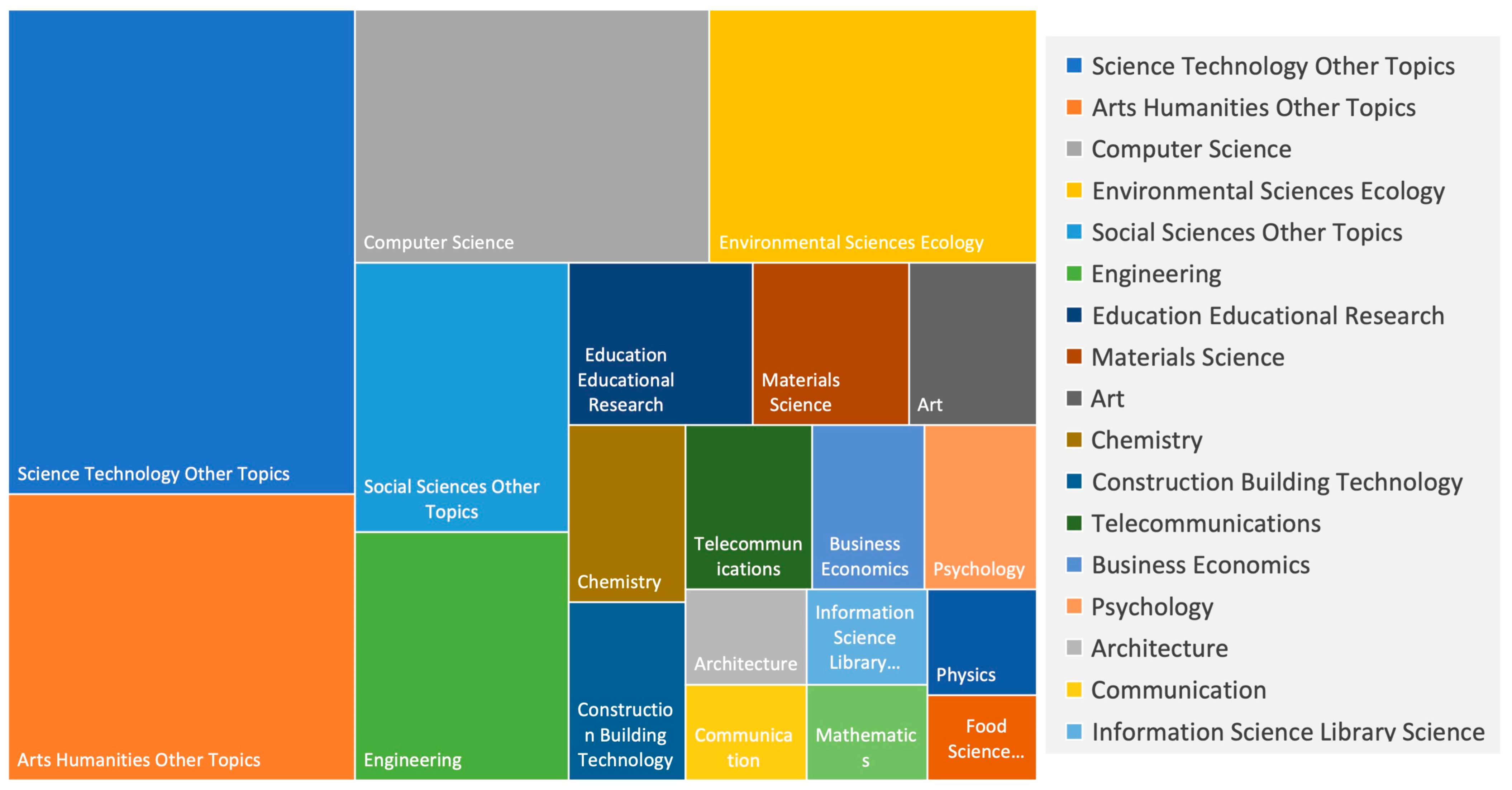
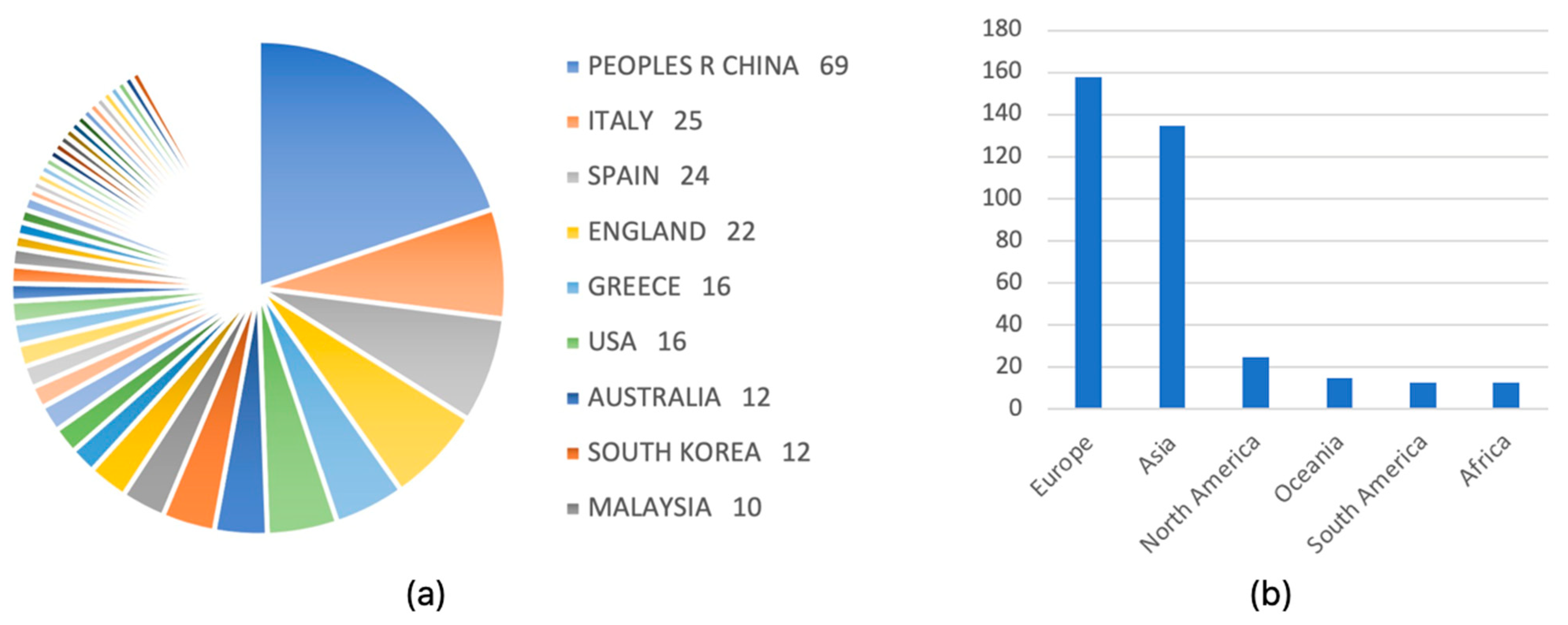
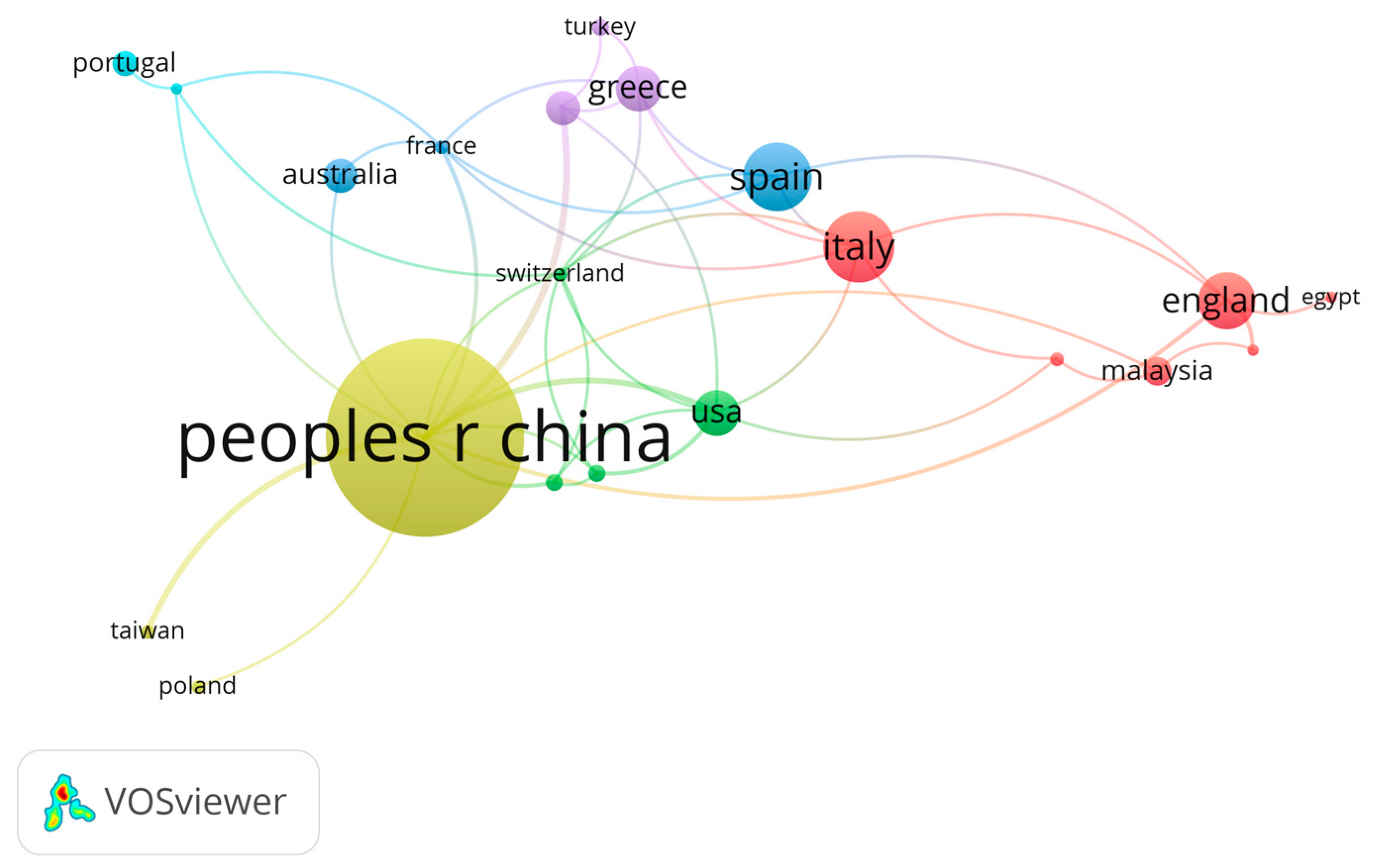
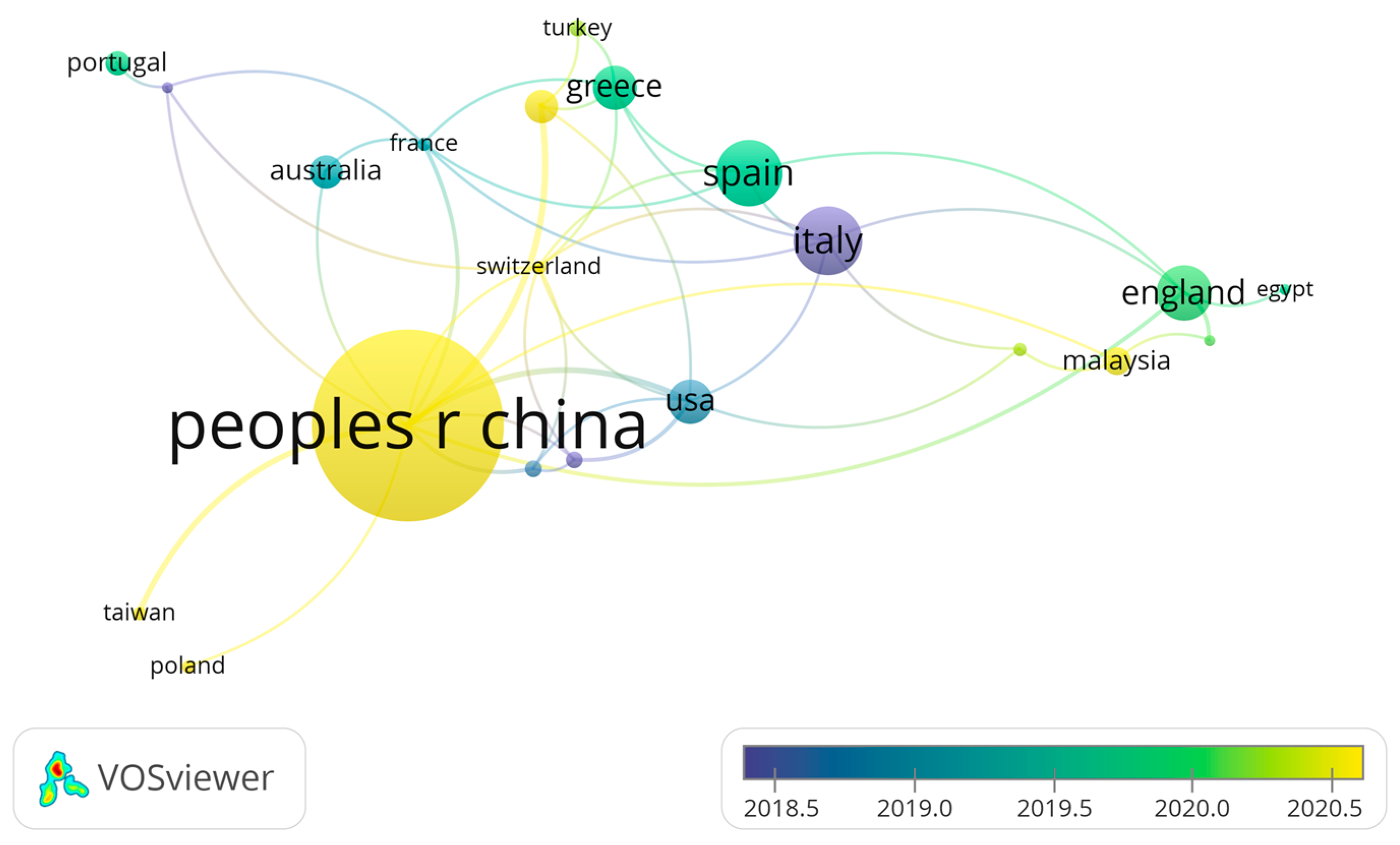
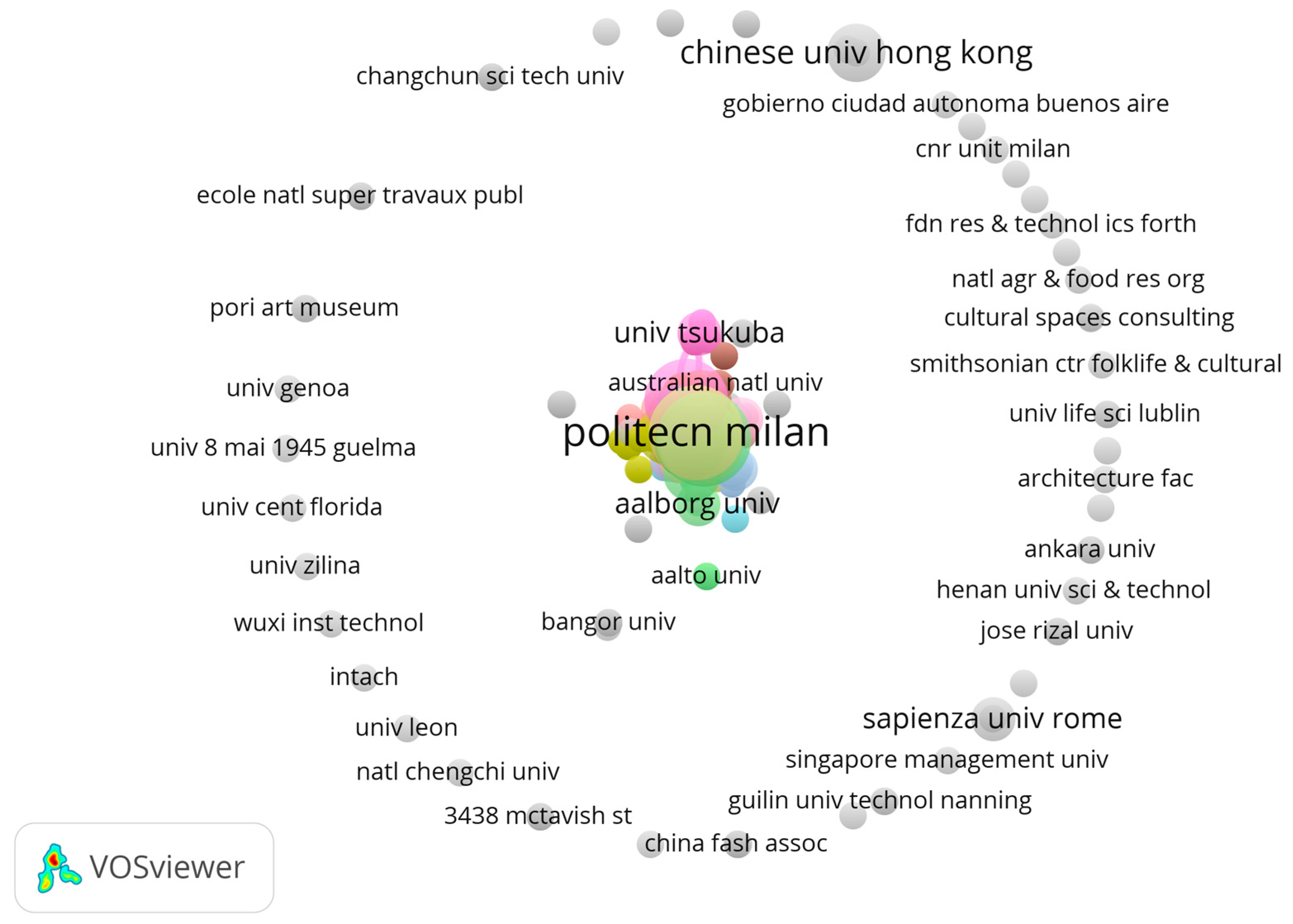
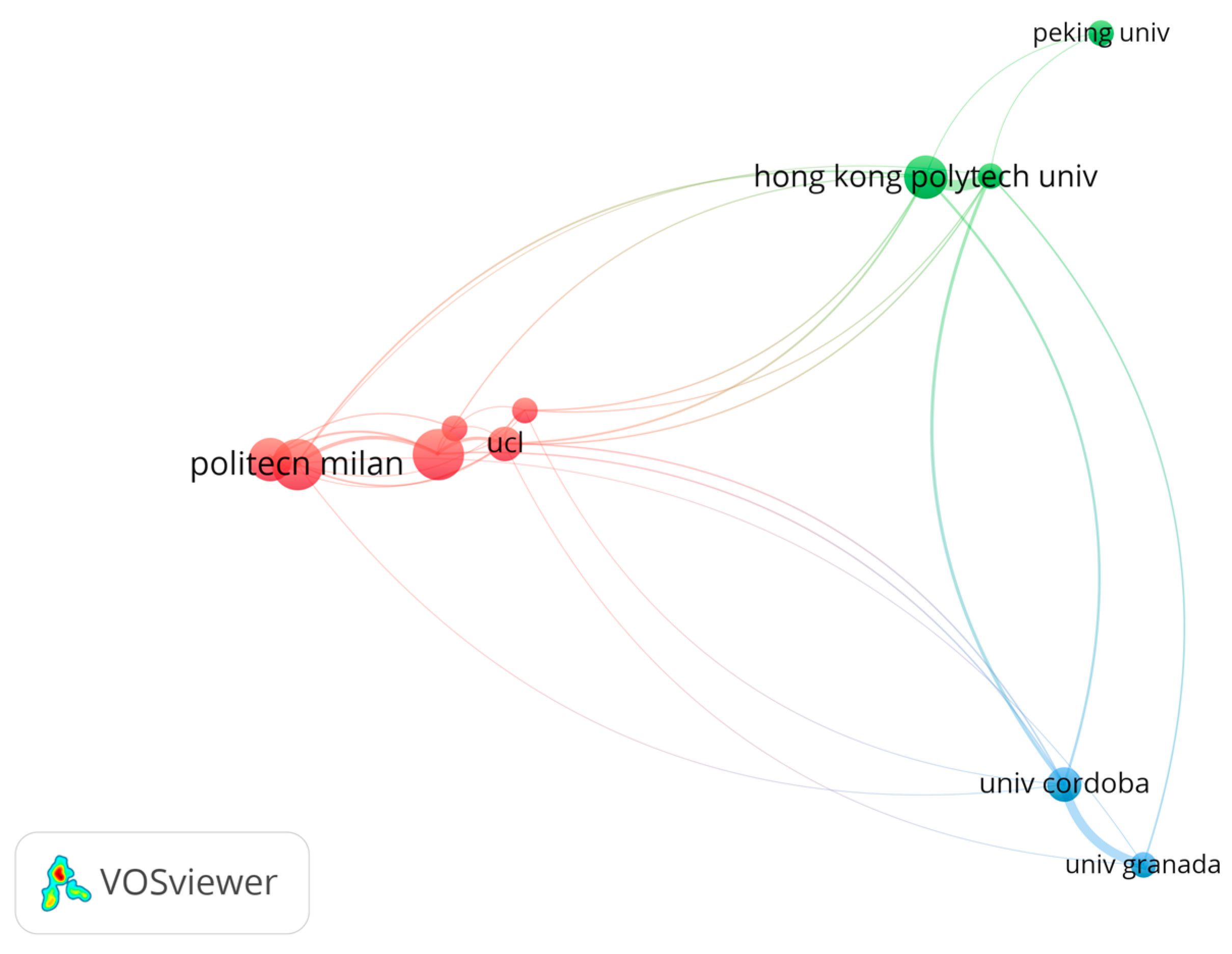
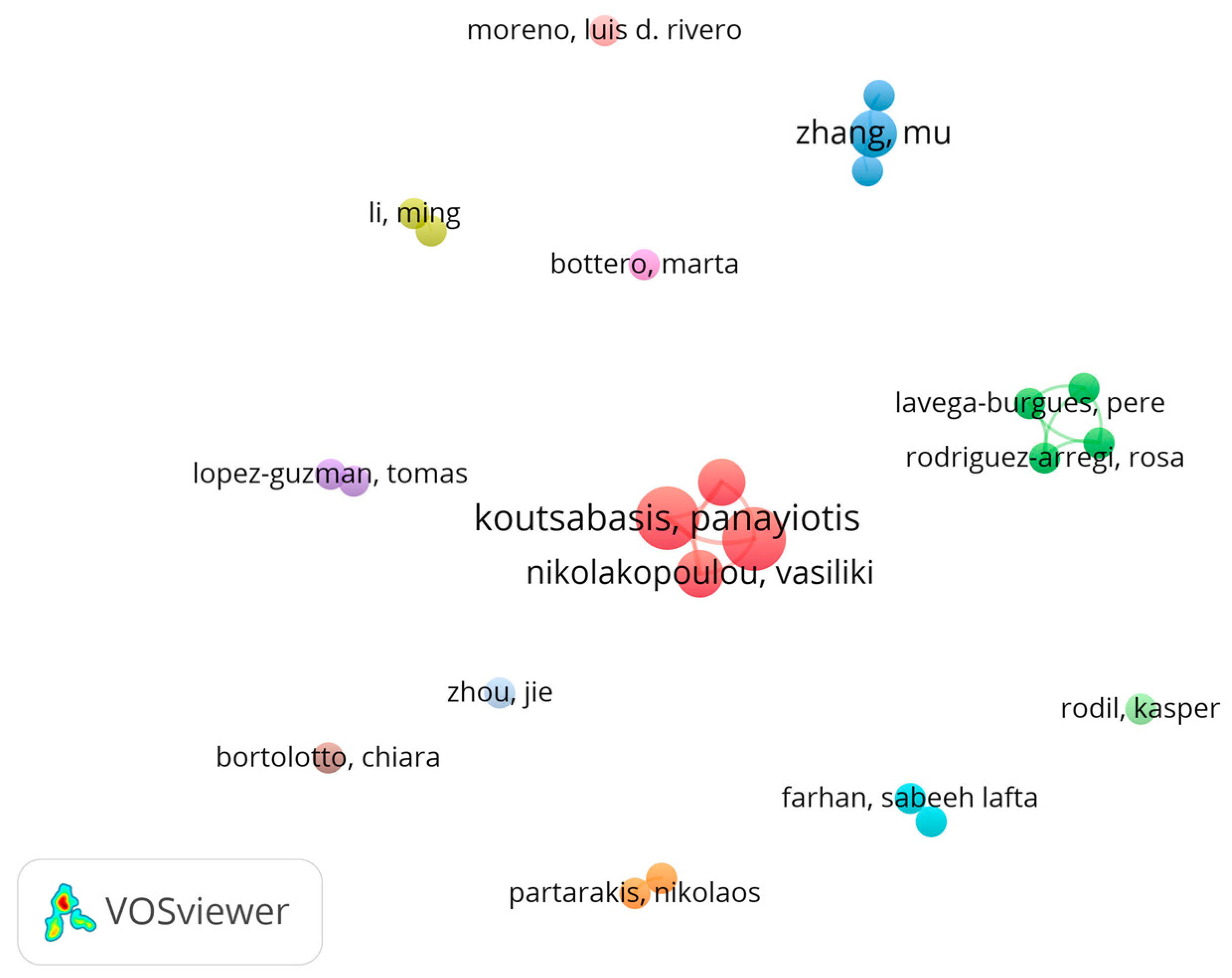
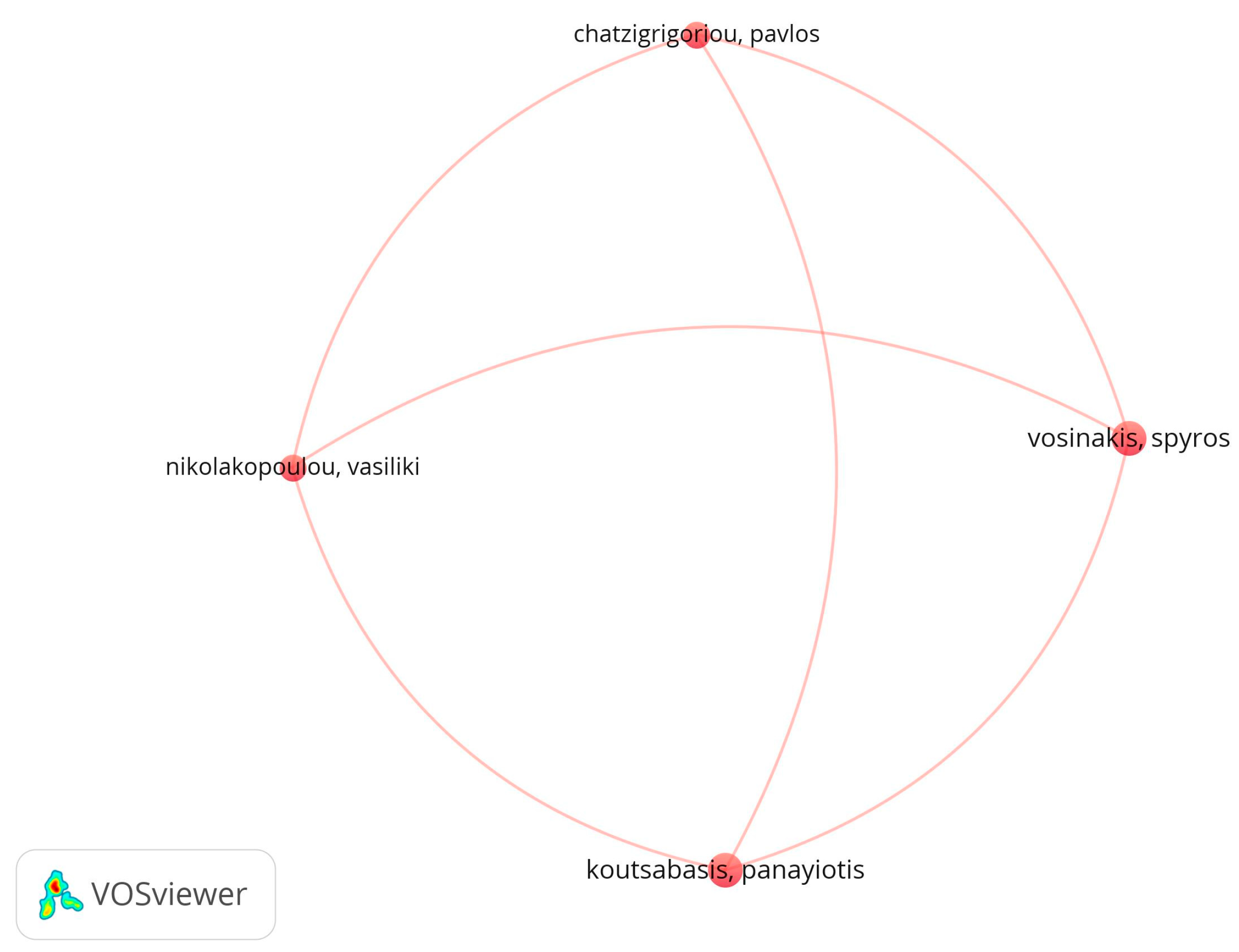
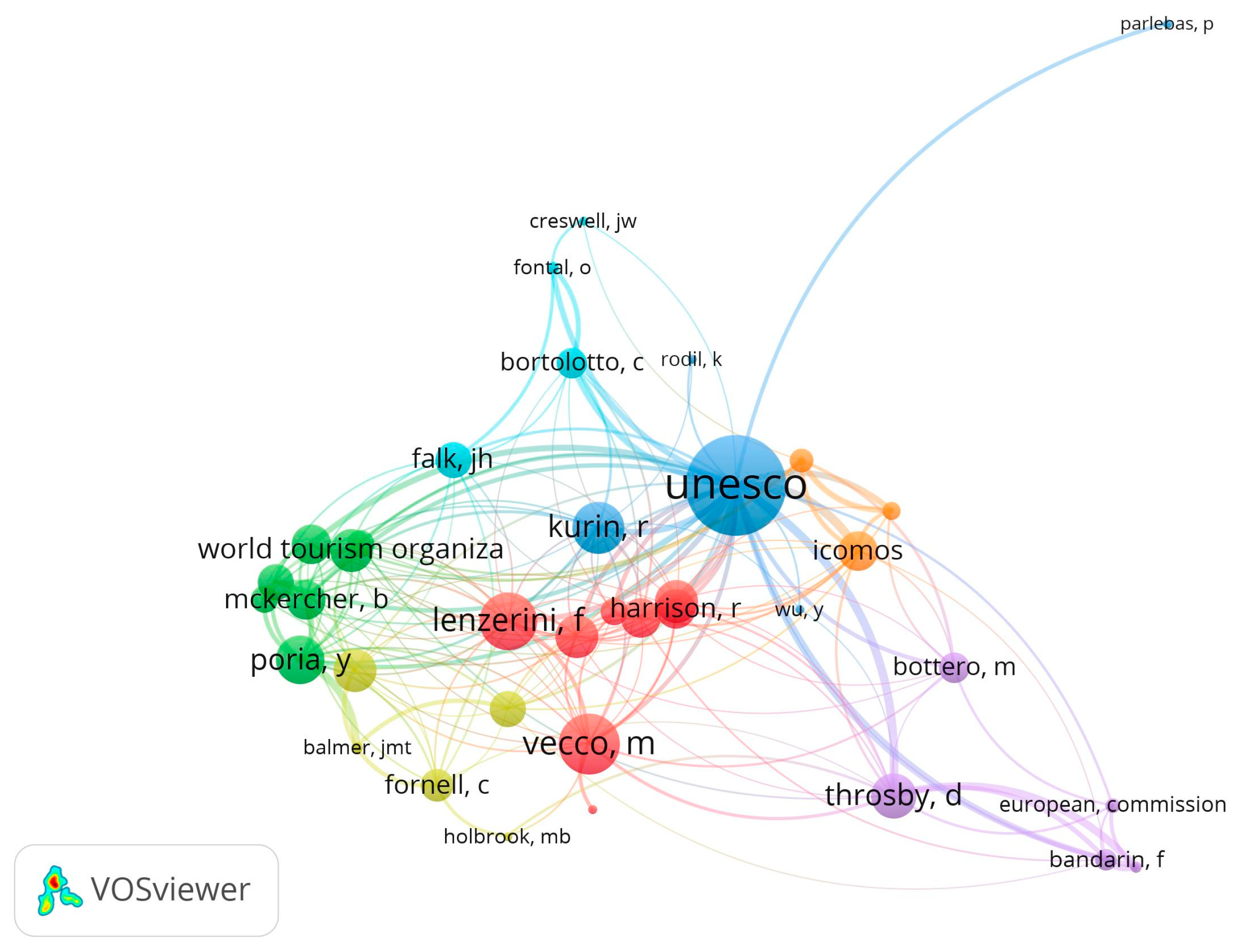
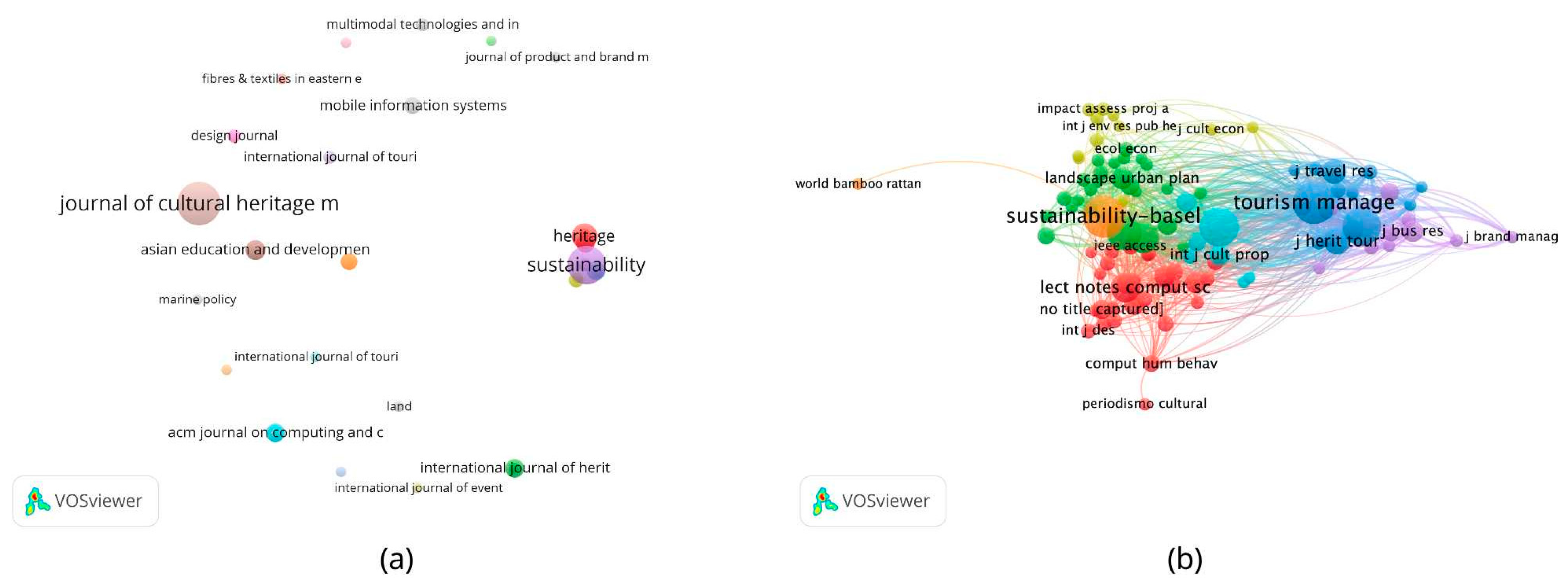

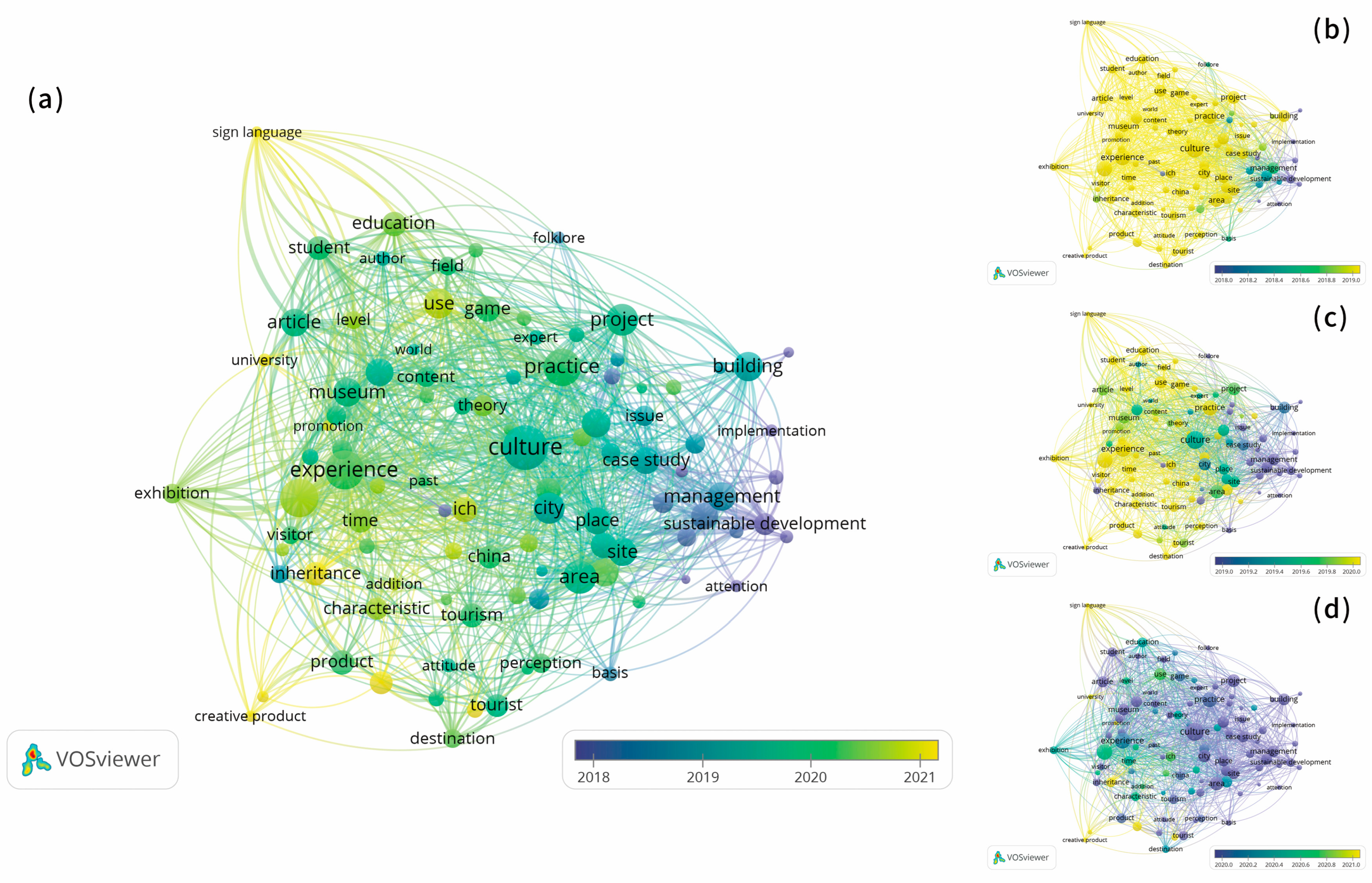

| R | Affiliation | Country | TP | TC | TC/TP | H |
|---|---|---|---|---|---|---|
| 1 | Polytechnic University of Milan | Italy | 6 | 67 | 11.17 | 3 |
| 2 | University of Aegean | Greece | 6 | 41 | 6.83 | 4 |
| 3 | Hong Kong Polytechnic University | Hong Kong, China | 5 | 54 | 10.80 | 3 |
| 4 | Polytechnic University of Turin | Italy | 5 | 92 | 18.40 | 3 |
| 5 | University of London | United Kingdom | 5 | 124 | 24.80 | 3 |
| R | Journal | Editorial | JCI | JCI Category | CQ | TP | TC | TC/TP | MCA |
|---|---|---|---|---|---|---|---|---|---|
| 1 | Journal of Cultural Heritage Management and Sustainable Development | MDPI | 0.18 | GREEN AND SUSTAINABLE SCIENCE AND TECHNOLOGY(ESCI) | Q4 | 32 | 68 | 2.13 | [53] |
| 2 | Sustainability | Emerald Group Publishing | 0.65 | ENVIRONMENTAL STUDIES(SSCI) | Q3 | 25 | 207 | 8.28 | [54] |
| 3 | Heritage | MDPI | 4.12 | HUMANITIES, MULTIDISCIPLINARY(ESCI) | Q1 | 11 | 21 | 1.91 | [55] |
| 4 | Asian Education and Development Studies | Taylor and Francis | 0.32 | EDUCATION AND EDUCATIONAL RESEARCH(ESCI) | Q3 | 7 | 9 | 1.29 | [56] |
| 5 | ACM Journal on Computing and Cultural Heritage | National Folk Museum of Korea | 4.08 | HUMANITIES, MULTIDISCIPLINARY(AHCI) | Q1 | 6 | 31 | 5.17 | [57] |
| 6 | Frontiers in Psychology | Association for Computing Machinery | 1.03 | PSYCHOLOGY, MULTIDISCIPLINARY(SSCI) | Q2 | 6 | 1 | 0.17 | [58] |
| 7 | International Journal of Heritage Studies | Emerald Group Publishing | 3.28 | HUMANITIES, MULTIDISCIPLINARY(AHCI) | Q1 | 6 | 142 | 23.67 | [59] |
| 8 | International Journal of Intangible Heritage | Frontiers Media | 1.36 | HUMANITIES, MULTIDISCIPLINARY(AHCI) | Q1 | 6 | 26 | 4.33 | [60] |
| 9 | Applied Sciences Basel | MDPI | 0.59 | ENGINEERING, MULTIDISCIPLINARY(SCIE) | Q2 | 5 | 14 | 2.80 | [61] |
| R | Author | TP | TC | Links | Total Link Strength |
|---|---|---|---|---|---|
| 1 | Koutsabasis, Panayiotis | 4 | 30 | 3 | 6 |
| 2 | Vosinakis, Spyros | 4 | 30 | 3 | 6 |
| 3 | Zhang, Mu | 3 | 67 | 0 | 0 |
| 4 | Chatzigrigoriou, Pavlos | 3 | 10 | 3 | 6 |
| 5 | Nikolakopoulou, Vasiliki | 3 | 10 | 3 | 6 |
| R | Author | Citations | Links | Total Link Strength |
|---|---|---|---|---|
| 1 | UNESCO | 159 | 33 | 414 |
| 2 | Icomos | 22 | 13 | 82 |
| 3 | Throsby, D | 20 | 15 | 113 |
| 4 | Vecco, M | 20 | 20 | 64 |
| 5 | Smith, L | 19 | 13 | 49 |
| Typical Keywords | Links | Total Link Strength | Occurrences | Avg. Pub. Year |
|---|---|---|---|---|
| heritage | 50 | 5304 | 363 | 2019.2039 |
| approach | 50 | 3167 | 184 | 2019.0924 |
| culture | 50 | 2644 | 138 | 2019.4275 |
| element | 50 | 1814 | 112 | 2020.2321 |
| role | 50 | 1554 | 70 | 2018.6 |
| practice | 50 | 1497 | 102 | 2020.0784 |
| city | 48 | 1445 | 74 | 2019.2027 |
| project | 50 | 1397 | 78 | 2019.7308 |
| community | 49 | 1360 | 87 | 2019.2414 |
| management | 44 | 1280 | 64 | 2018.6562 |
| area | 49 | 1223 | 86 | 2019.7209 |
| sustainable development | 46 | 1177 | 43 | 2015.7674 |
| building | 40 | 1101 | 68 | 2019.1471 |
| sustainability | 47 | 1057 | 50 | 2020.1 |
| landscape | 45 | 1030 | 60 | 2018.3167 |
| originality value | 48 | 1023 | 49 | 2020.1429 |
| place | 49 | 932 | 59 | 2019.4746 |
| case study | 49 | 908 | 58 | 2019.1379 |
| resource | 49 | 896 | 52 | 2019.8077 |
| conservation | 48 | 850 | 49 | 2018.0612 |
| identity | 49 | 773 | 53 | 2019.434 |
| unesco | 48 | 597 | 37 | 2018.2973 |
| order | 46 | 529 | 33 | 2018.2424 |
| Typical Keywords | Links | Total Link Strength | Occurrences | Avg. Pub. Year |
|---|---|---|---|---|
| intangible cultural heritage | 50 | 3555 | 236 | 2020.5975 |
| technology | 50 | 1957 | 106 | 2020.6132 |
| model | 50 | 1511 | 105 | 2020.3048 |
| protection | 50 | 1366 | 63 | 2020.2857 |
| knowledge | 50 | 1155 | 63 | 2020.5079 |
| product | 48 | 1139 | 80 | 2020.75 |
| inheritance | 42 | 840 | 47 | 2021.9787 |
| time | 48 | 839 | 48 | 2020.4792 |
| ich | 47 | 815 | 54 | 2020.7407 |
| effect | 48 | 744 | 45 | 2021.0444 |
| china | 46 | 671 | 46 | 2020.0652 |
| country | 47 | 599 | 35 | 2020.0286 |
| cultural identity | 46 | 510 | 25 | 2019.88 |
| dissemination | 46 | 420 | 28 | 2020.75 |
| digital technology | 42 | 393 | 24 | 2020.1667 |
| authenticity | 39 | 354 | 18 | 2020 |
| Typical Keywords | Links | Total Link Strength | Occurrences | Avg. Pub. Year |
|---|---|---|---|---|
| addition | 44 | 330 | 18 | 2020.6667 |
| exhibition | 36 | 1096 | 36 | 2020.4444 |
| experience | 50 | 2162 | 112 | 2020.1786 |
| museum | 42 | 1194 | 67 | 2019.806 |
| music | 45 | 678 | 30 | 2018.8333 |
| tourist | 47 | 663 | 45 | 2019.8222 |
| visitor | 45 | 889 | 31 | 2020.0323 |
| Typical Keywords | Links | Total Link Strength | Occurrences | Avg. Pub. Year |
|---|---|---|---|---|
| article | 48 | 1039 | 63 | 2019.8095 |
| author | 46 | 472 | 22 | 2019.3182 |
| factor | 48 | 690 | 37 | 2020.3514 |
| innovation | 46 | 601 | 35 | 2019.8571 |
| student | 40 | 940 | 48 | 2020 |
| RQ | Objective | Methods | Findings |
|---|---|---|---|
| 1 | Publications and Citations by year | Analysis of Publications and Citations by year. | Publications and citations have grown exponentially in recent years. |
| Publications by Subject Areas | Analysis of Publications by Subject Areas. | Focus on sustainable science and technology, comprehensive humanities, environmental research, etc. | |
| Publications by countries/regions | Firstly, an analysis of the number of publications by country/regions and Intercontinental. Then, use network visualization and overlay visualization of co-authorship analysis in VOSviewer. | Mainly European and Asian countries, of which China is the largest output country. | |
| Publications by Institutions and their collaboration network | First, analyze what institution the publication comes from using the Bibliographic coupling analysis method in VOSviewer. Then, network visualization is performed by setting different minimum numbers of documents for an organization’s parameters. | Polytechnic University Of Milan, University Of Aegean, and Hong Kong Polytechnic University are the top-producing institutions in this field. There is also some level of collaboration between institutions, but they tend to collaborate more internally. | |
| Publications by Journals and authors | First, we will analyze the journals with the highest number of published articles. Next, we will use the collaborative relationship network analysis method in VOSviewer to show the cooperative relationship between authors. | Research articles related to this field are published in various journals in different fields. Journals under the MDPI publishing house have a significant influence in this field. The researchers in this field are relatively dispersed, and although there is some collaboration, the degree of collaboration is not high. | |
| Citation analysis | Using VOSviewer, first, analyze the citation and co-citation structures. Then, analyze the authors with the highest citation and co-citation counts. Finally, analyze the resources with the highest citation and co-citation counts. | Based on the analysis, there is a certain degree of knowledge dissemination and exchange, but overall, it is not very tight. | |
| 2 | Theme hotspot analysis | By using VOSviewer, a co-occurrence network analysis of textual data was conducted to obtain the topic density of keywords. | The research interest is high and is increasingly following new technologies and concepts, but the research coverage needs to be expanded. |
| Theme evolution analysis | By using VOSviewer to analyze the co-occurrence network of terms in textual data, we have obtained a superimposed view of the main topics of the keywords in different time periods. | The research topics in this field have shifted from protection management and policy studies to culture, cultural heritage, cultural identity, and innovation, and then to practical utilization and industrial development. This adjustment process involves a shift from macro to micro perspectives and a greater focus on practical applications. | |
| Theme cluster analysis | From the VOSviewer software, a co-occurrence network analysis was conducted on the text data, and key themes, networks, and clusters of keywords were identified. A selection of high-frequency words from the clusters was used to build the basic data for correlation analysis. The Pearson correlation coefficient was calculated using the Pearson correlation analysis method to examine the significance of the correlation coefficients between variables. | Four clusters are identified. Cluster 1: Management and Sustainable Development of Cultural Heritage; Cluster 2: Protection and Transmission of ICH; Cluster 3: Museum Management and Visitor Experience; Cluster 4: Education and Academic Research. |
Disclaimer/Publisher’s Note: The statements, opinions and data contained in all publications are solely those of the individual author(s) and contributor(s) and not of MDPI and/or the editor(s). MDPI and/or the editor(s) disclaim responsibility for any injury to people or property resulting from any ideas, methods, instructions or products referred to in the content. |
© 2023 by the authors. Licensee MDPI, Basel, Switzerland. This article is an open access article distributed under the terms and conditions of the Creative Commons Attribution (CC BY) license (https://creativecommons.org/licenses/by/4.0/).
Share and Cite
Liu, S.; Pan, Y. Exploring Trends in Intangible Cultural Heritage Design: A Bibliometric and Content Analysis. Sustainability 2023, 15, 10049. https://doi.org/10.3390/su151310049
Liu S, Pan Y. Exploring Trends in Intangible Cultural Heritage Design: A Bibliometric and Content Analysis. Sustainability. 2023; 15(13):10049. https://doi.org/10.3390/su151310049
Chicago/Turabian StyleLiu, Sixuan, and Younghwan Pan. 2023. "Exploring Trends in Intangible Cultural Heritage Design: A Bibliometric and Content Analysis" Sustainability 15, no. 13: 10049. https://doi.org/10.3390/su151310049
APA StyleLiu, S., & Pan, Y. (2023). Exploring Trends in Intangible Cultural Heritage Design: A Bibliometric and Content Analysis. Sustainability, 15(13), 10049. https://doi.org/10.3390/su151310049






